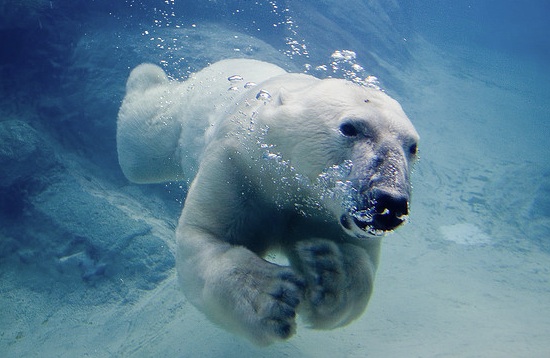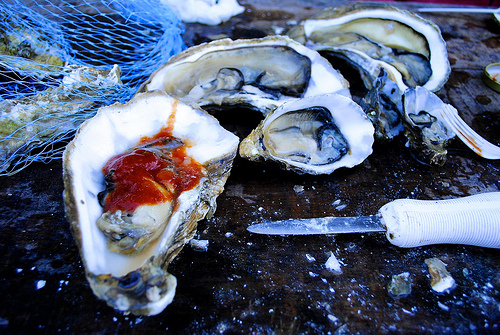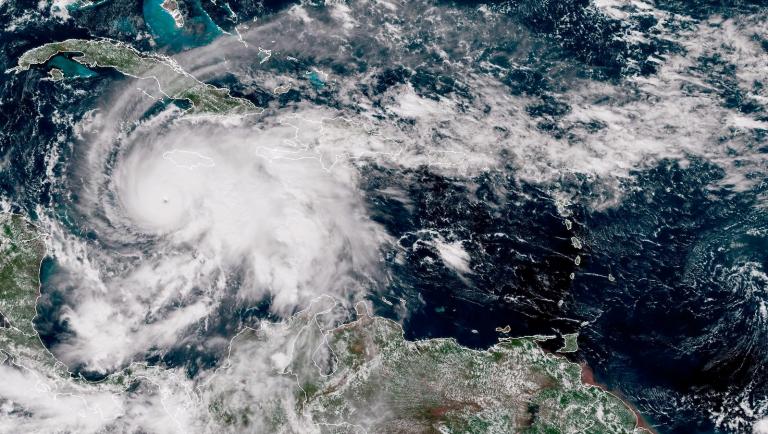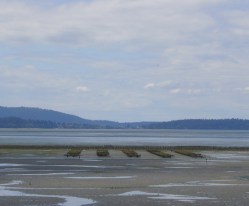
An oyster farm in Washington. (Photo by Kent Wang.)
The first suspects were bacteria.
Something was killing the microscopic oyster larvae at the hatcheries in Washington’s Dabob Bay and in Oregon’s Netarts Bay in recent years. The tiny oyster shells were crumbling faster than they could grow back, says Bill Dewey, public policy director for Taylor Shellfish Farms, which harvests geoducks, oysters, and other shellfish around Puget Sound. And soon, hatchery experts realized increasing ocean acidification was the true culprit. But what exactly that means, is yet to be determined.
“Ocean debasification is a bit awkward and not scientifically precise,” says Jan Newton, a senior principal oceanographer at the University of Washington.
Think back to high school chemistry and “pH,” which measures the acidity or alkalinity of a fluid on a 14-point scale. The lower the number, the more acidic something is. Distilled water is a seven and is considered “neutral.” Sea water’s pH is normally 8.1 to 8.2 on the alkaline side, where as black coffee’s pH is five on the acidic side. Orange juice’s pH is three. Battery acid is in the neighborhood of one.
Well, shellfish survive within a narrow pH spectrum. Taylor Shellfish’s oyster hatchery — located in the Hood Canal fjord jutting out from Puget Sound — lets sea water in at two locations, one that’s 15 feet deep and one that’s 100 feet deep. One day last week, the pH of the water at 15 feet was 8.4, while the water’s pH at 100 feet deep was 7.5, meaning the hatchery has to be especially careful about where its water comes from.
Scientists around the world have been studying ocean acidification in labs for decades, and many have been tracking shellfish hatcheries along the Oregon and Washington coasts. But the deaths of these baby oysters in the Pacific Northwest are the first confirmed cases of increasing ocean acidification killing aquatic creatures in the real world. And, in an area where shellfish harvesting is a $270 million-a-year industry that employs about 3,200 people, this is a big cause for concern.
In addition to the losses at Taylor Shellfish, Oregon State University researchers announced a definite link at another hatchery in Oregon.
Ocean acidification has been traced to two primary sources — carbon dioxide in the air and nitrogen-laden nutrients seeping from cities, septic tanks, and agriculture into the ocean. Carbon dioxide is also known as “the acid gas,” because it increases the acidity of the water it’s in, says Shallin Busch, a research ecologist with the National Oceanic and Atmospheric Administration’s (NOAA) Northwest Fisheries Science Center. NOAA set up the lab in Seattle two years ago to study ocean acidification. There, scientists are examining the effect of variables such as carbon dioxide, oxygen, and temperature on more than a dozen species of fish, shellfish, crabs, and squid.
Scientists have found that the ocean’s increased acidity corrodes calcium carbonate — the stuff that shellfish shells are made out of. Winds, currents, water depth, time of day, seasonal shifts, and even geographical features have all been linked to the ebb and flow of acidic sea water.
Ocean acidification is increasing, and that increase is accelerating, says Busch. Near the beginning of the Industrial Revolution — 250 years ago — the atmosphere’s carbon dioxide content is said to have been roughly 280 parts per million (ppm). Today, we’re at about 390 ppm. The increase in carbon dioxide density in the air — and in the sea — is expected to significantly accelerate this century.
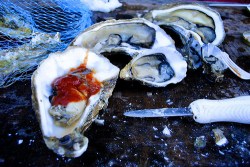
Photo by Harry Chen.
These are the issues being examined by a panel convened recently by Washington’s Gov. Chris Gregoire (D). The panel — a collection of scientists, shellfish industry officials, and federal and state government types — will focus on the current science and recommend how Washington can tackle ocean acidification along its coasts. This is the first state effort of its kind in the nation.
“We’re experiencing the impact of acidity before the rest of the world. … It scared the pants off us,” says Jay Manning, an environmental lawyer, the former chief of staff to Gregoire, and the panel’s co-chair.
U.S. Sen. Maria Cantwell (D-Wash.) agrees. She recently held a press event at Taylor Shellfish addressing the issue of acidification and the potential impact on the state. “Ocean acidification is a major threat to Washington state’s coastal economy and thousands of jobs,” she told reporters.
Potential measures include legislation to trim carbon emissions and deal with nutrient-laden fluids — such as sewage and storm water. It’s also possible that planting kelp and eel grass could help absorb excessive carbon dioxide in the water. Scientists are also looking at putting iron pellets in the ocean — which would act similarly to phytoplankton in drawing carbon dioxide out of seawater.
Of course, it’s not like the ocean knows state boundaries. And Washington’s coastal waters make up a mere drop in the bucket.
“It’s a global problem. There’s not much that Washington can do by itself,” Manning says.
However, there are several NOAA representatives on the Washington panel, meaning the federal government will be kept in the loop about the panel’s conclusions and recommendations.
Washington D.C. participation cannot be taken for granted. The Obama administration’s federal budget had recently trimmed $2.5 million from NOAA’s ocean acidification monitoring efforts. But Cantwell led a push to convince the U.S. Senate’s Appropriations Committee to restore the money last Thursday. That appropriation includes $250,000 to maintain a half-dozen federal buoys off Washington’s coast, plus links to another 20 buoys owned by other entities.
Installed in 2010, the buoys hold sensors that can measure and transmit real-time weather and pH data to NOAA.
“With this monitoring equipment, we’re able to see corrosive water coming and dodge it,” Dewey says. In other words, hatcheries would be able to gauge when to allow sea water into the hatcheries.
David Steele, president of the Pacific Coast Shellfish Growers Association, is optimistic. “By keeping these sensors in the water,” he adds, “we can learn more about the changing water chemistry and develop ways to adapt.”
